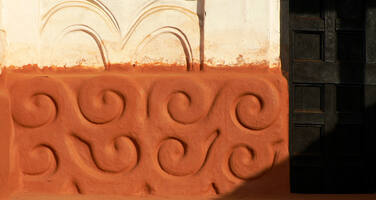Asante Traditional Buildings
Factors affecting the property in 1996*
- Human resources
- Land conversion
- Pests
- Water (rain/water table)
International Assistance: requests for the property until 1996
Total amount approved : 0 USD
Missions to the property until 1996**
Information presented to the Bureau of the World Heritage Committee in 1996
Description and present state of conservation: The property, as inscribed on the World Heritage List in 1980, consists of thirteen traditional Asante buildings, all associated with the institution of chieftaincy and/or the indigenous animist religion. All are single-storey, wattle-and-daub and/or monolithic earth constructions, decorated in the traditional Asante manner, and are fine examples of the small and still diminishing number of traditional structures surviving in the forest belt of Ghana. All except two have been taken into the custody of the Ghana Museums and Monuments Board (GMMB). They have undergone a programme of repair and conservation, and are periodically inspected. Most of the conservation work was carried out in the 1960's and early 1970's; the prolonged period of economic depression in Ghana, from the mid 1970's to the late 1980's, has put an effective brake on the Monuments Board's conservation programme in the Ashanti region.
The state of conservation report identifies several factors that affect the property such as:
Staffing levels: Current levels of staffing in the Monuments Division, GMMB, regionally, and salaries/wages for management and employees of the GMMB nationally, are inadequate for the current responsibilities of the Monuments Division within the region to be properly sustained, let alone for the extension of those responsibilities which the envisaged developments referred to in the preceding section would require.
Environmental pressures: The only significant environmental pressures which adversely affect these properties are: (1) the warm humid tropical climate, which is destructive for traditional earth and wattle-and-daub buildings - heavy rain erodes the foundations and wall bases, high by destructive insects breed prolifically; and (2) intensification of agricultural development making the traditional building materials - thatching materials, bamboo, specific timber species - less easily obtainable.
Action Required
The Bureau, concerned by the inadequate level of resources available for the conservation of the fragile Ashanti Traditional Buildings recommended that the Ghana Museums and Monuments Board prepare comprehensive conservation and site management plans within the context of envisaged regional integrated development programmes. It requested the Ghana authorities to inform the World Heritage Committee before its twenty-first session at the latest, on the initiatives taken in this matter.
Summary of the interventions
Decisions adopted by the Committee in 1996
20 BUR IV.7
Ashanti Traditional Buildings (Ghana)
The Bureau, concerned by the inadequate level of resources available for the conservation of the fragile Ashanti Traditional Buildings recommended that the Ghana Museums and Monuments Board, in cooperation with the Centre, prepare comprehensive conservation and site management plans within the context of envisaged regional integrated development programmes. It requested the Ghana authorities to inform the World Heritage Committee before its twenty-first session at the latest, on the initiatives taken in this matter.
* :
The threats indicated are listed in alphabetical order; their order does not constitute a classification according to the importance of their impact on the property.
Furthermore, they are presented irrespective of the type of threat faced by the property, i.e. with specific and proven imminent danger (“ascertained danger”) or with threats which could have deleterious effects on the property’s Outstanding Universal Value (“potential danger”).
** : All mission reports are not always available electronically.


